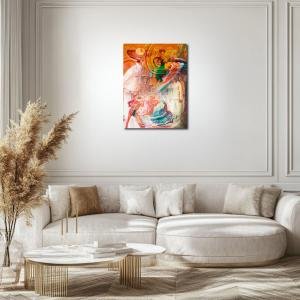The Last Supper: Wings of Divinity and Human Emotion
"The Last Supper: Wings of Divinity and Human Emotion" reimagines Leonardo da Vinci’s iconic mural through a conceptual lens, blending human drama with divine symbolism. Angelic wings envelop the scene, symbolizing transcendence and spiritual protection, while soft, dreamlike colors evoke purity and introspection. Flowing patterns and luminous light create a surreal atmosphere, emphasizing the connection between earthly conflict and heavenly peace. This reinterpretation invites viewers to reflect on timeless themes of betrayal, forgiveness, and redemption, honoring Leonardo’s legacy while infusing the work with contemporary resonance.
Please see Below for Details…
Hotline Order:
Mon - Fri: 07AM - 06PM
404-872-4663
Leonardo da Vinci’s The Last Supper (1495–1498) is widely recognized as one of the most influential artworks in Western art history. Painted on the wall of the Convent of Santa Maria delle Grazie in Milan, the mural represents the moment Jesus announces that one of his apostles will betray him. This reinterpretation transforms Leonardo’s iconic composition into a deeply symbolic, conceptual artwork that blends divine and human realms through ethereal visual metaphors and delicate imagery.
In the original mural, Leonardo masterfully captured the psychological turmoil and individual reactions of the apostles, depicting their shock, denial, and confusion. The apostles are arranged in groups of three, their gestures and facial expressions forming a rhythmic dialogue that converges at the serene figure of Christ at the center. The vanishing perspective lines, with Jesus as the focal point, create a sense of depth and spiritual gravity. This conceptual reinterpretation amplifies these qualities, intertwining the human drama with divine symbolism.
The most striking feature of this new composition is the incorporation of angelic wings, which envelop the scene like a protective embrace. The wings symbolize transcendence and the divine presence, subtly reminding viewers of the spiritual context of the Last Supper. The feathers dissolve into light, creating a soft, luminous atmosphere that elevates the earthly event into a heavenly vision. The use of wings, a motif often associated with purity and guidance, emphasizes the duality of Jesus’ role as both human and divine.
The subtle, dreamlike colors enhance the emotional depth of the artwork. The soft whites and creamy yellows of the background convey a sense of purity and peace, contrasting with the turmoil depicted among the apostles. The pastel tones of blues, reds, and greens in the apostles’ clothing maintain the harmony of Leonardo’s original palette while infusing the scene with a contemporary ethereal quality. The transparency of the colors mirrors the fragility of the moment, reflecting the tension between betrayal and forgiveness, doubt and faith.
The incorporation of abstract elements, such as the flowing lines and feather-like patterns that merge into the composition, adds a surreal dimension. These elements suggest the omnipresence of divine energy, gently blurring the boundaries between the earthly and the heavenly. The juxtaposition of the table, an anchor of humanity, with the celestial wings above creates a visual metaphor for the connection between mortality and eternity.
As an artist, the reinterpretation of The Last Supper is an exploration of timeless themes: the complexity of human relationships, the weight of moral decisions, and the interplay between the divine and the human. Leonardo’s original work stands as a testament to his genius in capturing both the physical and the emotional essence of his subjects. This reimagined piece seeks to honor that legacy while inviting viewers to reflect on the spiritual significance of the event and its relevance to contemporary life.
The wings, extending outward from the scene, symbolize the spread of Christ’s teachings and the enduring power of forgiveness. The serene expression of Christ, coupled with the dramatic reactions of the apostles, highlights the universal struggle between inner peace and external chaos. This tension is further emphasized by the soft, glowing light that permeates the composition, suggesting hope and redemption amidst conflict.
The choice of colors plays a crucial role in conveying the emotional tone of the artwork. The muted whites and yellows evoke divinity and purity, while the transparent hues of the apostles’ clothing represent vulnerability and introspection. The flowing patterns of light and shadow create a sense of movement and continuity, reflecting the perpetual relevance of Leonardo’s masterpiece.
This conceptual reinterpretation also examines the role of perspective and symmetry in storytelling. While the original work used perspective lines to draw attention to Christ, the addition of angelic wings and light beams expands the focus, creating a visual narrative that transcends the confines of the room. The interaction between the apostles, with their varied gestures and expressions, remains central, reminding viewers of the deeply human aspect of the Last Supper.
The emotional resonance of this artwork lies in its ability to blend the familiar with the transcendent. It preserves the essence of Leonardo’s masterpiece while offering a new lens through which to experience its themes. The wings, light, and flowing patterns encourage contemplation, inviting viewers to connect with the spiritual dimensions of the scene and reflect on their own struggles with faith, forgiveness, and human frailty.
Add your review
Your email address will not be published. Required fields are marked *
Please login to write review!
Looks like there are no reviews yet.










